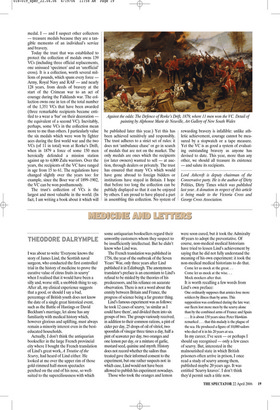THEODORE DALRYMPLE
I was about to write ‘Everyone knows the story of James Lind, the Scottish naval surgeon, who conducted the first controlled trial in the history of medicine to prove the curative value of citrus fruits in scurvy’ when I realised that it would have been a silly and, worse still, a snobbish thing to say. After all, my clinical experience suggests that a good, or should I say a bad, percentage of British youth does not know the date of a single great historical event, such as the Battle of Hastings or David Beckham’s marriage, let alone has any familiarity with medical history which, however glorious and uplifting, must always remain a minority interest even in the besteducated households.
Actually, I don’t think the antiquarian bookseller in the large French provincial city where I bought the French translation of Lind’s great work, A Treatise of the Scurvy, had heard of Lind either. He looked at me over the upper rim of those gold-rimmed half-moon spectacles perched on the end of his nose, so wellsuited to the superciliousness with which some antiquarian booksellers regard their unworthy customers whom they suspect to be insufficiently intellectual. But he didn’t know who Lind was.
The French translation was published in 1756, the year of the outbreak of the Seven Years’ War, only three years after Lind published it in Edinburgh. The anonymous translator’s preface is an encomium to Lind’s refusal to be misled by the theories of his predecessors, and his reliance on accurate observation. There is not a word about the enmity between Britain and France, the progress of science being a far greater thing.
Lind’s famous experiment was as follows: he took 12 cases of scurvy, ‘as similar as I could have them’, and divided them into six groups of two. The groups variously received, in addition to their common rations, a pint of cider per day, 25 drops of oil of vitriol, two spoonfuls of vinegar three times a day, half a pint of seawater per day, two oranges and one lemon per day, or a mixture of garlic, mustard seed, quinine and myrrh. History does not record whether the sailors thus treated gave their informed consent to the experiment, but one rather suspects not: in which case, Lind would not have been allowed to publish his experiment nowadays.
Those who took the oranges and lemon were soon cured, but it took the Admiralty 40 years to adopt the preventative. Of course, non-medical medical historians have tried to lessen Lind’s achievement by saying that he did not fully understand the meaning of his own experiment: it took the non-medical medical historians to do that.
Come let us mock at the great.. .
Come let us mock at the wise.. .
Mock mockers after that.
It is worth recalling a few words from Lind’s own preface:
One ordinarily supposes that armies lose more soldiers by illness than by arms. This supposition was confirmed during the late war; our fleets lost more men by the scurvy alone than by the combined arms of France and Spain ... It is about 150 years since Peter Hawkins remarked ... that this malady is the plague of the sea. He produced a figure of 10,000 sailors who died of it in his 20 years at sea.
In my career, I’ve seen — or perhaps I should say recognised — only a few cases of scurvy. But, interested in the malnourished state in which British prisoners often arrive in prison, I once read a study of scurvy among them, published maybe 20 years ago. It was entitled ‘Scurvy knaves’. I don’t think they’d permit such a title now.


































































 Previous page
Previous page